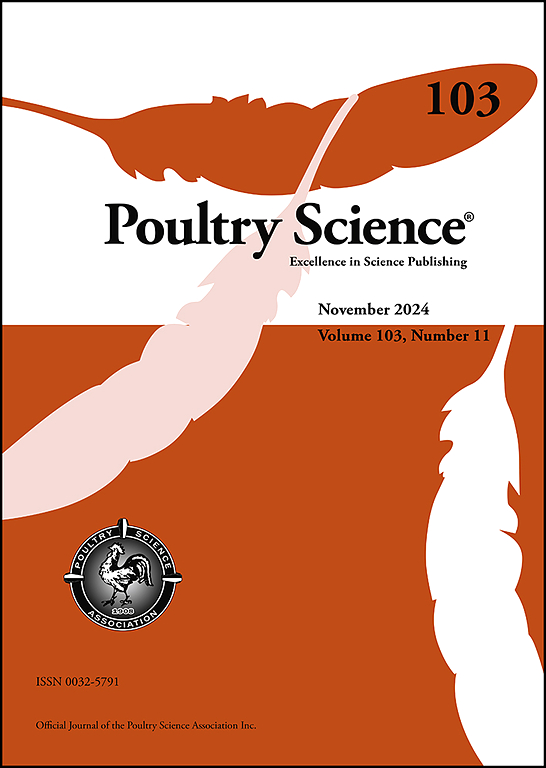基于磁共振成像的蛋黄重量和百分比无损测量
IF 4.2
1区 农林科学
Q1 AGRICULTURE, DAIRY & ANIMAL SCIENCE
引用次数: 0
摘要
随着鸡蛋加工业的发展和对蛋黄粉需求的增加,高效无损检测蛋黄百分比的方法受到了人们的广泛关注。现有的无损检测技术对棕色鸡蛋的检测精度往往有限。为了建立无损蛋黄测量的最佳设置,我们比较了磁共振成像(MRI)场强,发现3.0 T具有最佳性能。在此基础上,我们使用3D切片器软件建立了标准化的成像工作流程,实现了蛋黄体积和其他相关参数的无损测量。为了建立稳健的预测模型,我们扫描了360个白鸡蛋和750个棕色鸡蛋,通过图像分割算法分离蛋黄,计算蛋黄体积、表面积和Feret直径等参数。使用70/30的数据集分割,表现最好的模型在训练集和测试集中分别获得了0.893和0.907的高决定系数(r²),显示出出色的预测准确性。该模型能够在不同条件下(包括不同蛋壳颜色和储存时间)准确预测蛋黄重量和百分比,进一步证明了该模型的实用性。模型分析显示,罗德岛红(RIR)褐蛋蛋黄重和蛋黄率显著低于白莱霍恩(WL)白蛋(P < 0.001),长期贮藏显著提高了这两个参数(P < 0.001)。对RIR鸡蛋的遗传分析也得出了蛋黄重量的遗传力估计为0.39,蛋黄百分比的遗传力估计为0.42。在安全性方面,MRI暴露对孵化率无显著影响,治疗组的孵化率为93.3%,对照组为86.7% (P > 0.05)。本研究为快速、无损地测定蛋黄含量提供了一种有效的解决方案,将极大地促进蛋鸡生产,并最终支持蛋品加工业的发展。本文章由计算机程序翻译,如有差异,请以英文原文为准。
Non-destructive measurement of egg yolk weight and percentage based on magnetic resonance imaging
With the expanding egg processing industry and increasing demand for egg yolk powder, efficient non-destructive methods for detecting yolk percentage have garnered significant attention. Existing non-destructive testing techniques frequently exhibit limited accuracy for brown eggs. To establish the optimal setup for non-destructive yolk measurement, we compared magnetic resonance imaging (MRI) field strengths and found that 3.0 T provided the best performance. Building on this, we established a standardized imaging workflow using 3D Slicer software, enabling non-destructive measurement of yolk volume and other relevant parameters. To build a robust predictive model, we then scanned 360 white eggs and 750 brown eggs, isolating the yolk via image segmentation algorithms to calculate parameters such as yolk volume, surface area, and Feret’s diameter. Using a 70/30 dataset split, the best-performing model achieved high coefficients of determination (r²) of 0.893 and 0.907 in the training and test sets, respectively, demonstrating excellent predictive accuracy. The model’s utility was further demonstrated by its ability to accurately predict yolk weight and percentage under varying conditions, including different shell colors and storage times. Analysis using the model revealed significantly lower yolk weight and percentage in Rhode Island Red (RIR) brown eggs compared to White Leghorn (WL) white eggs (P < 0.001), and long-term storage significantly increased these parameters (P < 0.001). Genetic analysis of RIR eggs also yielded heritability estimates of 0.39 for yolk weight and 0.42 for yolk percentage. Regarding safety, MRI exposure had no significant effect on hatchability, with a rate of 93.3 % in the treated group compared to 86.7 % in the control group (P > 0.05). This study provides an effective solution for rapid, non-destructive measurement of yolk percentage, which will significantly benefit layer production and ultimately support the development of the egg processing industry.
求助全文
通过发布文献求助,成功后即可免费获取论文全文。
去求助
来源期刊

Poultry Science
农林科学-奶制品与动物科学
CiteScore
7.60
自引率
15.90%
发文量
0
审稿时长
94 days
期刊介绍:
First self-published in 1921, Poultry Science is an internationally renowned monthly journal, known as the authoritative source for a broad range of poultry information and high-caliber research. The journal plays a pivotal role in the dissemination of preeminent poultry-related knowledge across all disciplines. As of January 2020, Poultry Science will become an Open Access journal with no subscription charges, meaning authors who publish here can make their research immediately, permanently, and freely accessible worldwide while retaining copyright to their work. Papers submitted for publication after October 1, 2019 will be published as Open Access papers.
An international journal, Poultry Science publishes original papers, research notes, symposium papers, and reviews of basic science as applied to poultry. This authoritative source of poultry information is consistently ranked by ISI Impact Factor as one of the top 10 agriculture, dairy and animal science journals to deliver high-caliber research. Currently it is the highest-ranked (by Impact Factor and Eigenfactor) journal dedicated to publishing poultry research. Subject areas include breeding, genetics, education, production, management, environment, health, behavior, welfare, immunology, molecular biology, metabolism, nutrition, physiology, reproduction, processing, and products.
 求助内容:
求助内容: 应助结果提醒方式:
应助结果提醒方式:


